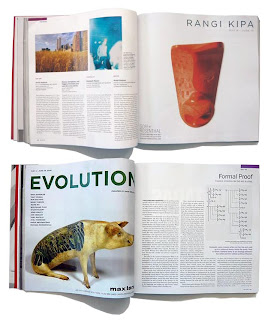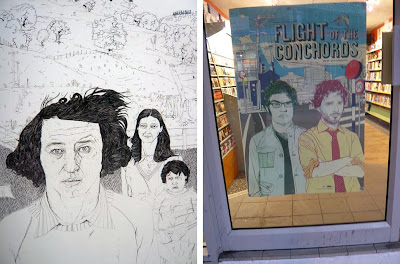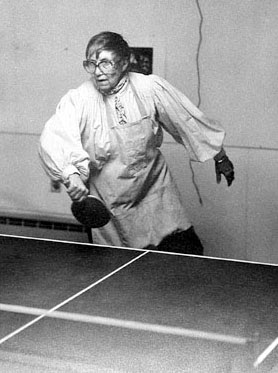
Last month we: went to a James Bond movie to search for a Goya • thought about light boxes • did three pipes thinking about sculpture theft • avoided making the “they’re in it for the Monet” pun • got over excited about Sean Connery playing ping pong half naked • worked out where Weta got the idea from (Duh!) • did it by the numbers • premiered worm art • followed up on the heart and dagger affair • mashed our two favourite themes – disaster movies and art • saw some bad art at the airport • watched Hans Josephsohn getting the shove in Piccadilly • graciously held back from posting the header ‘some day my plinth will come" and looked at crates.
Saturday, May 31, 2008
May days
If you build it they will come
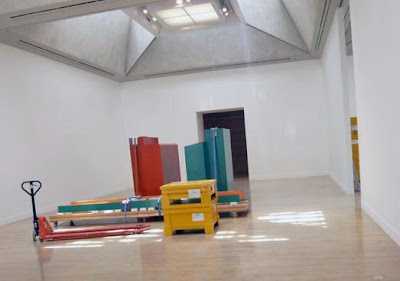
A while back we were wondering about the power if the art gallery context and how a random pile of road working equipment might be received by visitors to an art gallery. Well, here’s a go. This collection of crates, moving equipment and bits of art at Tate Britain managed to get a regular (and generally thoughtful) audience. Thanks Rauschenberg, Beuys, Andre, et al.
Posted by
jim and Mary
at
7:30 AM
![]()
![]()
Friday, May 30, 2008
My watch has stopped too
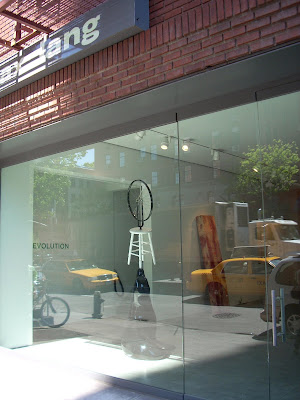
The other day we posted on Duchamp’s readymade Bicycle Wheel, having just seen it at the Tate, and last month we mentioned that Michael Parekowhai was showing at the Max Lang gallery (way back we put up a pic of the ornamental china seal that started the whole thing off). Today a reader sends this pic of Parekowhai’s My Sister, My Self from the streets of New York city. Spooky. Thanks R
Posted by
jim and Mary
at
11:45 AM
![]()
![]()
Labels: parekowhai
The art work formally known as Plinth

The new Lord Mayor of London has threatened to cancel the Trafalgar Square Fourth Plinth programme and replace the series of contemporary art projects with a bronze sculpture of a war hero. Unfortunately the current lack-lustre plinth effort by artist Thomas Schütte won’t help those arguing for the programme continuing. Will our own copy-cat version of the plinth project come under similar attack? Our Minister of the Arts rushed across the Tasman only a few months ago to dedicate a bronze soldier on a plinth. New Zealand’s top soldier statue sculptor, Alan Somerville, is no doubt pacing the floor, waiting for the phone to ring.
Images: Plinths in Trafalgar Square, right sculpture by Thomas Schütte
Posted by
jim and Mary
at
7:34 AM
![]()
![]()
Labels: public sculpture
Thursday, May 29, 2008
After shock
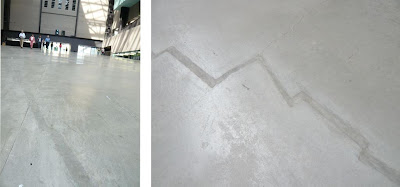
By the time we got to the Tate Doris Salcedo’s Shibboleth installation in the turbine hall (a 167 meter fracture in the concrete floor) was over. But looking down at our feet it was easy to see where the fissure had been. Carefully filled by technicians the crack lives on as a ghostly drawing. With news of the China quake still on the front pages of UK papers Salcedo’s work, even in this erased form, is still capable of creating a powerful impact.
Posted by
jim and Mary
at
9:13 AM
![]()
![]()
Wednesday, May 28, 2008
Court news
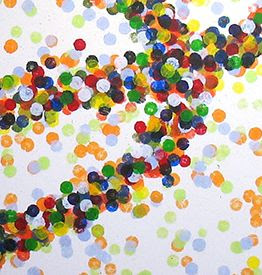
Ok, it isn’t done with ping pong balls (and probably isn’t art) but it looks like the sort of thing that will be eagerly taken up by elephants and chimps everywhere. As OTN is an information portal for animal art, let us tell you about the abstract paintings of tennis super star Martina Navratilova. Her idea? To hit paint-covered tennis balls onto canvas and create an exhibition called Art Grand Slam. The first venue was Perth earlier this year, and they loved it. There hasn’t been this much excitement on the burning rock since penis painter Tim Patch. Navratilova is currently showing in London and is set to tour GSA to other key cities. Why did New Zealand miss out on this subtle combination of sport and art? Balls-up.
Image: Navratilova’s Way of My Life
Posted by
jim and Mary
at
8:32 AM
![]()
![]()
Labels: animal art
Tuesday, May 27, 2008
Head job
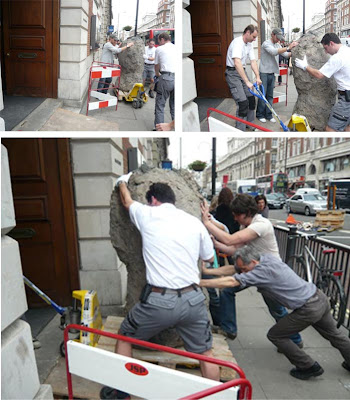
The business of art is not just rough wine (and cheese if you can get it). These pics were taken outside Hauser & Wirth in Piccadilly where, after being disappointed that there was no show - this was the gallery where Paul McCarthy opened with a performance including the usual sauces and a person dressed up as the Queen Mother after all. As you can see, we were stopped in the street by workers pushing heavy Hans Josephsohn heads into the gallery. The Hauser & Wirth space was originally a bank – still is.
Posted by
jim and Mary
at
6:31 PM
![]()
![]()
Monday, May 26, 2008
The wheel thing

How many of you have stepped into a great museum and headed straight to the bookshop first? Be honest. We were doing just that at Tate Modern the other day and saw this miniature Duchamp wheel for sale as tie in to a Duchamp, Picabia, Man Ray exhibition. When we saw Michael Parekowhai’s version of this Duchamp work balanced on the tip of a seal’s nose, the conceit of making a ready made seemed perfect – a nice balance between homage and interrogation. But making miniature versions in China and boxing them up on behalf of the Duchamp Foundation and the Philadelphia Museum seems a big step in another direction. You can here them round the table discussing merchandise, “The boss made miniatures for his valises, let’s do it.”
Posted by
jim and Mary
at
6:54 AM
![]()
![]()
Labels: mechandice
Saturday, May 24, 2008
Thinking of Justin Paton
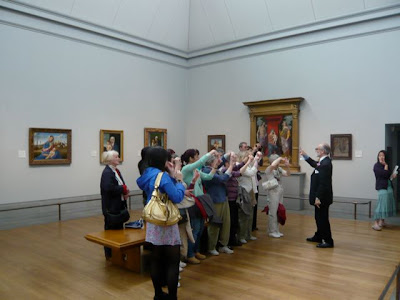
We were told there was no photography allowed at the National Gallery so when we saw what we thought was a group standing in front of a painting all taking photographs in unison, we took one of our own. After being ticked off by the guard, we realised that what the members of the group were actually doing was making a square shape with their fingers to create a viewing frame. It was how-to-look-at-a-painting 101.
Posted by
jim and Mary
at
7:33 AM
![]()
![]()
Friday, May 23, 2008
Filling the Gap
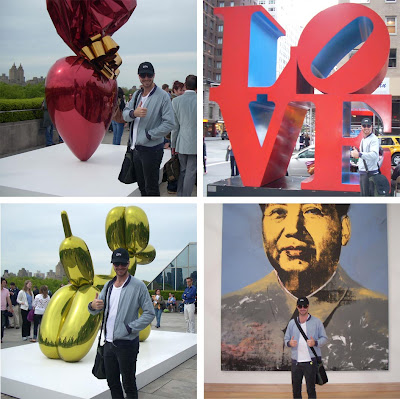
While the Gap and the Whitney were negotiating with artists on who would be seen modelling their artist edition t-shirts and who wouldn’t (yes say Kiki Smith and Ashley Bickerton, a no from Barbara Kruger and Jeff Koons), we had artist Ryan Moore undertake an international fashion shoot for the OTN cap. Here are the pics, each one featuring artist Moore wearing the latest OTN merchandise. Thanks R
Posted by
jim and Mary
at
6:42 PM
![]()
![]()
Labels: mechandice
Thursday, May 22, 2008
Crash landing

Sitting in the international Koru Lounge in Auckland is to witness the dying gasps of art as decor. This is posted from United's Hong Kong lounge where the art is both beautifully displayed and worth looking at for more than a tenth of a second. There was a time when the art at Air New Zealand lounges was selected from a decent range of artists and looked like someone cared about the hanging. No longer. Now it is done by some enterprise called the ArtPort (visit and weep) and is even allowed to join in the fun as background to a kids promotion. Never thought we would say this (and probably shouldn't) but come back John Daly-Peoples, all is forgiven.
Images: Top, Hong Kong. Bottom, Auckland
Posted by
jim and Mary
at
11:33 AM
![]()
![]()
Wednesday, May 21, 2008
Leaving home
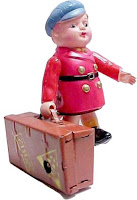 We will be out of New Zealand for the next two months so posting might be patchy. If you have RSS (there is a link on the right hand column of the blog) you will get to hear when we have posted something. If you don’t have RSS it will be catch as catch can but we promise we will be posting a new Big Ears from the Basel Art Fair. Anyway, we’re still keen to spread any news any of you think the public has a right to know or that would put a smile on the faces of our regular reader’s, send us an email.
We will be out of New Zealand for the next two months so posting might be patchy. If you have RSS (there is a link on the right hand column of the blog) you will get to hear when we have posted something. If you don’t have RSS it will be catch as catch can but we promise we will be posting a new Big Ears from the Basel Art Fair. Anyway, we’re still keen to spread any news any of you think the public has a right to know or that would put a smile on the faces of our regular reader’s, send us an email.
Posted by
jim and Mary
at
12:38 PM
![]()
![]()
The end of art history
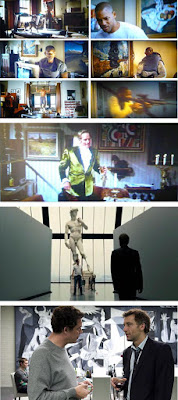
What happens to art when the world goes to hell in a hand-basket? If disaster movies are anything to go by, some of it at least gets saved, usually as décor for the resident hero in the resident hero’s residence. Will Smith is a bit of a legend when it comes to collecting art post apocalypse. His I am Legend character, Robert Neville, fills his apartment with Auction House Modern (in fact all in MoMA’s collections) including works by Basquiat, Haring, Dali, Rothko, Monet, Cezanne and Van Gogh’s The Starry Night. Things weren’t so classy for the original Legend Charlton Heston playing Dr Neville in The Omega Man, a 1971 version of Richard Matheson’s book I am Legend. With either limited taste, or time, this Doctor only managed to deck out his apartment in faux Delaunays, a suspect Monet and a wall of generics.
By 2027 tastes, and elan, have further developed and Nigel, one of the survivors in Children of Men has nabbed Picasso’s Guernica and Michelangelo’s David (a little the worse for wear) for himself. When the hero Theo meets with brother Nigel, in his office in the new Tate, they chat in front of Guernica. Nigel tells Theo, “We got to keep Las Meninas, and a few other Velázquez but we only got hold of two Goyas.” And then, “That thing in Madrid was a real blow to art.” (Thud).
Then there was Whistler’s Mother featuring in Rowan Atkinson's Bean: The Ultimate Disaster Movie. But that was a disaster of a completely different order.
(Click on images to enlarge)
Images: From the top, Will Smith does MoMA, Chalrton Heston is the art lovin’ Omega Man, the Men decorate the Tate with international art. Others in the series Art in the movies: A Clockwork Orange, A night at the movies, Wall Street, Dr No.
Posted by
jim and Mary
at
7:44 AM
![]()
![]()
Labels: art in the movies
Tuesday, May 20, 2008
A few days ago in history
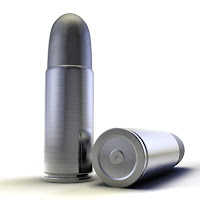
Anyone who follows the travails of the Sarjeant Gallery in Wanganui knows that they have a difficult time with their Mayor. No doubt they were thinking about this last Thursday on the anniversary of another Wanganui Mayor’s altercation with the arts. That day, in 1920, in his mayoral office, Wanganui Mayor Charles Mackay shot poet D’Arcy Creswell. Creswell survived, Mackay was imprisoned, and you can read the grisly details here. The Sarjeant Gallery was further connected to this event when Mackay’s name was removed from the Gallery’s foundation stone. It was reinstated in 1985.
Image: gratuitous picture of two bullets.
Just say no
 Know you’ll want to be alerted to the news that John Mills has been elected president of the Society for Promotion of Community Standards Inc. Mills was arrested in 1998 when Te Papa made its first and only foray into International contemporary art. The arrest was for his silent protest at the inclusion of Tania Kovat’s Virgin in a condom in the exhibition Pictura Britannica. Ian Wedde (a senior manager of Te Papa at the time) said that future exhibitions to be shown at Te Papa would need to be subject to risk assessment. And so they were.
Know you’ll want to be alerted to the news that John Mills has been elected president of the Society for Promotion of Community Standards Inc. Mills was arrested in 1998 when Te Papa made its first and only foray into International contemporary art. The arrest was for his silent protest at the inclusion of Tania Kovat’s Virgin in a condom in the exhibition Pictura Britannica. Ian Wedde (a senior manager of Te Papa at the time) said that future exhibitions to be shown at Te Papa would need to be subject to risk assessment. And so they were.
Monday, May 19, 2008
Nose job
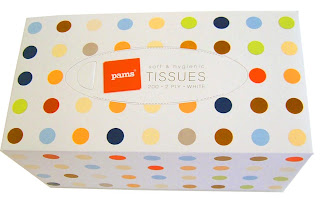
As we’re on a Hirst jag, now’s as good a time as any to alert you to the unlimited edition of Damien Hirst’s work available for the PRICE OF A BOX OF TISSUES!!! Pam’s in conjunction with White Cube Gallery in London has arranged this iconic Damien Hirst work to be on selected shelves in supermarkets near you. While Hirst is more famous for his dead animals, most critics agree that his dot works are a critical part of his practice. We’re told this is possibly the cheapest work by a living artist ever presented in New Zealand supermarkets.
Heartless
Interesting to watch two art stories playing out in two different cultures at the same time. In the United States the reaction to Robert Rauschenberg's death has been thoughtful and, although not always complimentary to the work, consistently serious about its place in the culture. The idea of Rauschenberg as an experimental artist has been central to most articles. Here the response to Damien Hirst's heart and dagger piece (a work that would not have been possible without Rauschenberg) has been uniformly trivial and focused on price, artist bashing and, in a new twist, custom's regulations . In fairness, this time it's not entirely the media's fault as Gow Langsford waved the million dollar price tag ahead of them like a red flag. They were also more than happy to prime the pump with another guaranteed headliner, the getting-weird-art-through-customs story. On cue, the media and a few of the regular curmudgeons shook the Hirst around like ratting dogs, as was intended. Interesting stuff, like how the heart and dagger fit into Hirst's work, how many examples there are and what it might be about was lost in the rush to create another oh-for-God's-sake art story.
Posted by
jim and Mary
at
7:25 AM
![]()
![]()
Labels: dealer gallery
Saturday, May 17, 2008
Advice to collectors
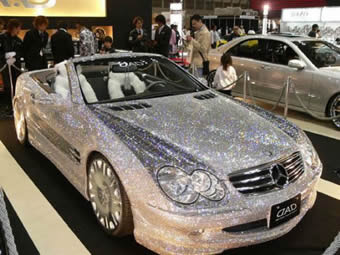
It's Saturday and so, your Hirst skull tucked under your arm, the heart and dagger safely tucked in the glove box, it's time to chuck the map in the trash, and hit the road.
Image: Mercedes Benz SL Model in Diamonds
Posted by
jim and Mary
at
8:41 AM
![]()
![]()
Labels: advice to collectors
Friday, May 16, 2008
Warning to collectors
As a postscript to our last post (and in the meantime a Francis Bacon has been knocked down for $US86 million) the Kaufmann house we posted on when we were in Palm Springs last year, was sold at the same auction for $US15 million. That’s nearly six of Richard Neutra’s masterpieces for one painting. The warning? Get out of real estate.
Posted by
jim and Mary
at
1:38 PM
![]()
![]()
Labels: architecture, auction, warning to collectors
Freudian
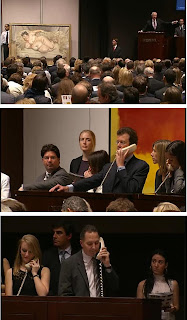
Is there still money in the art world? There is if you’re Brett or Emanuel’s phone bidders. Hold your breath and watch here as in New York Christie’s auctioneer takes Lucian Freud’s 1995 painting of Jobcentre manager Sue Tilley, Benefits Supervisor Sleeping, from an opening price of $16 million to a world record for a living artist at $US30 million ($US33,641,000 with commissions). Freud’s previous record price of $US19.3 million was set only six months ago. Let Sue Tilley have the last words, "I'm thrilled. I still can't believe such a bizarre thing has happened to me.”
Images: Top to bottom, the painting, Emanuel and, winner on the night, Brett.
Thursday, May 15, 2008
"Why make trillions when we can make...BILLIONS?"
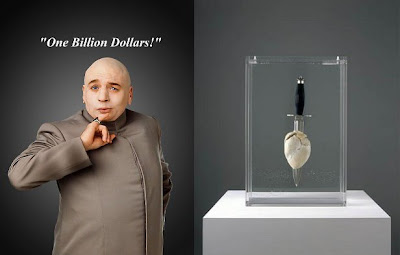
This mash-up from a reader, evidently referring to the million dollar price tag Gow Langsford have put on Damien Hirst’s Sacred XIV (2005). The editioned piece comes via White Cube, where ex-Sue Crockford staffer Richard Thompson and ex-McKay Gallery staffer Andrew Thomas now work. The purchase price was also the subject of much discussion (well, among the few New Zealanders anyway) at last year's Basel Art Fair. Anyone who can get what is probably a bull’s heart through NZ customs, even if it is suspended in a 5 percent solution of formaldehyde, deserves all the success in the world.
Image: Thanks to S, D, G and M
Posted by
jim and Mary
at
7:34 AM
![]()
![]()
Labels: dealer gallery
Wednesday, May 14, 2008
Poor Cow

“To live without art is to miss out on a vital dimension of life, to not have one of the senses. It is like cows who are so busy grazing they don't look up to see or react to a sunrise.”
James Wallace on the James Wallace Art Awards web site.
Posted by
jim and Mary
at
12:14 PM
![]()
![]()
Labels: Look alike
Robert Rauschenberg 1926 - 2008
Anyone who has seen Robert Rauschenberg’s Bed would understand what a shock it must have when first exhibited in 1955 (3 years before McCahon painted the Northland panels). In some ways his reputation has been clouded by the reception to his later work. For us he was an eye opener. Proof that beauty can be found anywhere. A good thing to know. We’re sad to announce that Robert Rauchenberg died on Monday at the age of 82.
Posted by
jim and Mary
at
10:21 AM
![]()
![]()
Good deal

Times have certainly changed in New Zealand dealer galleries as the photograph above shows. It is Martin Creed’s work number 329 Half the air in a given space at the Michael Lett Gallery in Auckland last year which now appears on the Hauser & Wirth web site. Apart from the nice tie-up with H&W this work is a marker of the growing familiarity we can now have with international art.
Was a time when, if you wanted to see art made by people off-shore, that was where you had to take your sorry self to see it. Now many of our dealer galleries regularly show or feature artists from all parts of the world. Excluding Australians, we have Gow Langsford with Katharina Grosse, Tony Cragg and Benar Venet, Hamish McKay’s long- time association with Jan van der Ploeg and NICJOB. Then there’s Sue Crockford with Boyd Webb and Daniel Buren plus of course Two Rooms Gallery’s residencies that have included Isaac Julien, Rana Islam (just nominated for this year's Turner Prize), and Paul Morrison. Add to that Starkwhite’s regular projects with overseas artists and Michael Lett’s Juliette Blightman and Chris Lopomi shows and you’re talking a rich and varied input from the private sector.
Image: Martin Creed, work number 329 Half the air in a given space at Michael Lett
Posted by
jim and Mary
at
7:14 AM
![]()
![]()
Labels: dealer gallery
Tuesday, May 13, 2008
The 5 percent solution
The Government is acting on its promise to introduce a resale royalty on the sale of artwork. The Copyright (Artists' Resale Right) Amendment Bill was introduced into Parliament today.
In its present form the legislation, if passed, will mean visual artists receive a 5 percent royalty payment each time one of their original art works (if worth more than $500) is resold commercially, through any auction house, gallery, dealer, or other intermediary or professional involved in the business of dealing in works of art. The royalties will be owed on work sold during the artist’s lifetime and for 50 years after the artist’s death.
On the road
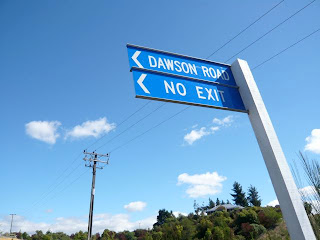
On the road is an ongoing series celebrating the Ministry of Land Transport and Local Body support of New Zealand artists.
Posted by
jim and Mary
at
11:39 AM
![]()
![]()
Labels: on the road
Face off
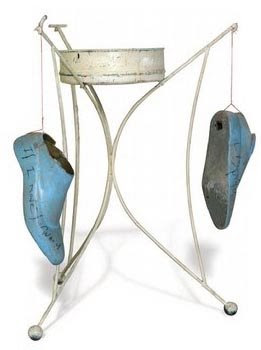
With their virtual online catalogue (the pages flip as you click), Webb’s have made another move to present themselves as the hippest auction house on the block. Both Webb’s and Art + Object feature videos of their staff ruminating over the excellence of their offerings, and both publish smart, surprisingly-shaped catalogues. But what does all this tell you, apart from the fact that people have stuff they want to sell to other people? From the promotional material put out by Webb’s you might think that they had moved house to avant-garde land. The sculptural piece If I move forward I will destroy myself by et al. is an unusual feature in this sort of publication. In the end though, the Webb’s catalogue doesn’t really live up to what its presentation promises. Like most New Zealand auctions the majority of the works are paintings and most of them by men.
Here’s a quick and dirty breakdown of the latest Webb’s and Art + Auction offerings.
Webb’s male artists 65% - Art + Object male artists 89%
Webb’s 3D works 20% - Art + Object 3D work 15%
Webb’s figurative 50.5% - Art + Object figurative 54%
And while in Art + Object’s catalogue around 90% of the artists are over 50, Webb’s has packed its offering with wet-off-the-wall works by youngsters in or just out of art school.
Image: The sculpture If I move forward I will destroy myself et al. that Webb's have featured on their ads
Monday, May 12, 2008
Ask the expert: Number 1

Q: What do you think of convicted double murderer Scott Watson’s paintings?
A: “A reasonable sense of colour.” “Some skills in manipulating the paint.”
Dr Pamela Gerrish Nunn Professor of Art History University of Canterbury quoted in this morning’s Dominion Post. Dr Nunn’s research interests are: women artists and issues of gender, 19th Century art, European art and Pre-Raphaelitism.
Posted by
jim and Mary
at
1:01 PM
![]()
![]()
Labels: ask the expert
By the numbers

1 The number of visual arts related events out of the 48 on offer at Te Papa in June.
2 The number of artists selected twice for the Walters Prize.
3 The number of times ‘ground breaking’ is used on the Govett-Brewster Art Gallery website to describe their collections.
3 The number of years Artbash has been live on the internet.
7.50 The cost in dollars for Aucklanders to see the Laurence Aberhart exhibition that was free in Dunedin and Wellington.
10 The number of key recommendations made by the Trip of a Lifetime Tour members in their delegation report.
18 The average number of positive reviews John Hurrell publishes a month on his blog eyeCONTACT.
34 The number of links under Christchurch in the Artbash Galleries links page.
75 The percentage of women directing public art galleries in the four main centers.
250 The number of Marti Friedlander photographs of models in the latest Prix-choc.
3288 The approximate number of days the longest-serving public art museum director, Paula Savage, has still to put in to equal the all-time record of 9496 days held by Bill Millbank at the Sarjeant Gallery in Wanganui.
17000 The number of US dollars a Finnish tourist was fined for chipping off the ear of an Easter Island statue as a souvenir.
Saturday, May 10, 2008
Copies cat
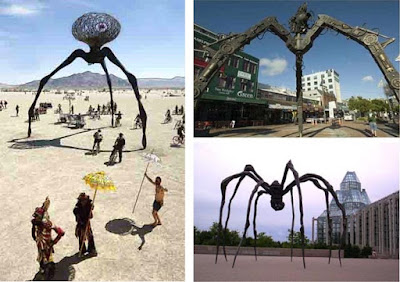
Weta can take comfort from the fact that somewhere out there, possibly at some crazy Burning Man like event, there are other Louise Borgouis copycats.
Images: Left recently discovered photo of crazy people in the desert dancing in front of weird Louise Borgouis-like sculpture. Right top, Weta effort in Wellington. Bottom the original from Louise Borgouis
Posted by
jim and Mary
at
7:56 AM
![]()
![]()
Labels: public sculpture, weta
Friday, May 09, 2008
Times tables
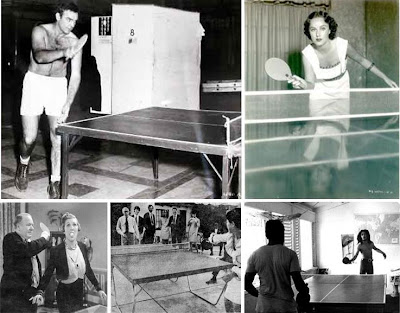
It was our fault for being smart arses, but you can all stop sending us jpgs of people playing table tennis. The series was called Famous Photographers Playing Table Tennis. For anyone who is after pictures of actresses, businessmen, cartoon characters and other people who are not famous photographers playing table tennis, you need to get yourselves over to the site Celebrities Playing Table Tennis.
Images from Celebrities_Playing_Table Tennis. Clockwise from top left, Sean Connery, Fay Wray, Bob Marley, Henry Miller and W C Fields
Posted by
jim and Mary
at
1:47 PM
![]()
![]()
Labels: photographers at play
Horsing around

Everyone who applauded the giant moose initiative, on Vithatten mountain in Sweden, will be delighted to hear that the UK has the opportunity to have its own oversized animal in a landscape. Mark Wallinger, ex horse painter and Turner Prize winner, is proposing a white horse to overlook the Ebbsfleet Valley. At 33 times life size it will kick Moose butt.
Images: Mark Wallinger's big horse on a hill concept. Bottom, moose
Posted by
jim and Mary
at
7:03 AM
![]()
![]()
Labels: giant horse, large animal sculpture, public sculpture
Thursday, May 08, 2008
A post without a Monet pun in its heading
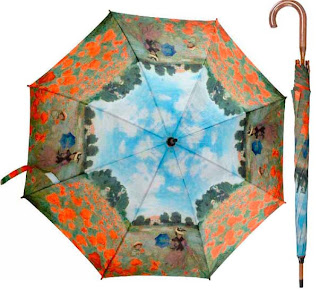
Te Papa may well have to go back to government with a reassessment of what the bill will be if their upcoming Monet exhibition goes up in flames or walks out the door. Last night at Christie’s Monet’s 1873 work The Railroad Bridge at Arenteuil sold at a record price for the artist of $US41.4 ($NZ52.9) million, SUS2.4 million above estimate. The painting last came up for sale in 1988 when the ticket price was $12.6 million. The price jump on Monets is comparatively recent, a previous record price of $US19.8 million set in 1998, held until mid last year.
Image: Monet mechandise
Posted by
jim and Mary
at
12:38 PM
![]()
![]()
Labels: blockbuster, Te papa
The Bronze age
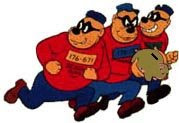
When the Wall Street Journal does an article on art thefts for scrap, it’s time to lock up your sculptures. The article was prompted by the theft about a year ago of John Kennedy’s The Spirit of Life. The 113 kilos of bronze were snatched in Brea California and no doubt scrapped. Since then a 2.1 meter 232 kilo bronze statue Miner has been taken from the Cathy Circle in LA. Valued at $125,000 it was expected to get about $900 as scrap.
In all the WSJ identifies eight sculpture thefts in the US over the last three years. Of course we had our own bronze age for sculpture theft in 2005. Most spectacular was Napier’s Pania of the Reef when was taken off its perch. Weighing in at 60 kilos she was probably worth around $30 as scrap but was found unharmed. There was a flurry of concern the same year when a guard was put on Wellington’s Bronze Form by Henry Moore, probably in sympathy for the one that was pinched the same year from the Henry Moore Foundation in England. In that case the 3.4 x 2.4 meter sculpture valued at $NZ7.5 million was simply loaded onto a Mercedes flat-bed lorry. The view at the time was that the Moore would be less valuable as scrap and had probably been shipped to the mysterious Argentine collector who buys all the stolen art in the world.
Meanwhile, in Wellington, Brenden John Marshall, possibly fired-up by the Pania heist, nicked a 3 x 3 metre sculpture from outside the Swell restaurant in Waikanae. Long Horizon by Paul Dibble was valued at $250,00. When he came to trial in July 2007, Marshall was also found guilty of blackmailing the owners by threatening to cut up the artwork and sell it for scrap if they did not pay a ransom. Marshall copped 300 hours of community work for his troubles. Who says art isn’t part of the real world?
A reader tells us that bronze is currently $18 per kilo. We also omitted to mention the five bronze sculptures by Greer Twiss stolen by thieves who used bolt cutters to break into the Wintergardens Fernery in the Auckland Domain in October 2007. Thanks W.
Posted by
jim and Mary
at
7:53 AM
![]()
![]()
Labels: public sculpture, theft
Wednesday, May 07, 2008
Loco
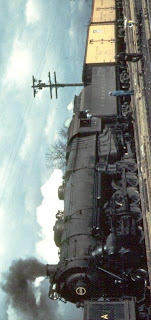 This is following up on our post about Jeff Koons’s proposed sculpture of a full-sized steam engine hanging from a crane outside the LA County Museum. Since then, we have discovered that the locomotive Koons’s suspended engine will replicate, was originally built by the Baldwin Locomotive Works in Philadelphia. So what, really? That is until you hear that the founder of the workshop that makes these monsters, Matthias W. Baldwin, started off as a jeweller and silversmith. In 1831 Baldwin was asked by the Philadelphia Museum to build a miniature locomotive for an exhibition. The miniature was such a success that Baldwin received an order for a full sized version! No big surprise then to also find out that Jeff Koons was born in York, Pennsylvania, just outside Philadelphia.
This is following up on our post about Jeff Koons’s proposed sculpture of a full-sized steam engine hanging from a crane outside the LA County Museum. Since then, we have discovered that the locomotive Koons’s suspended engine will replicate, was originally built by the Baldwin Locomotive Works in Philadelphia. So what, really? That is until you hear that the founder of the workshop that makes these monsters, Matthias W. Baldwin, started off as a jeweller and silversmith. In 1831 Baldwin was asked by the Philadelphia Museum to build a miniature locomotive for an exhibition. The miniature was such a success that Baldwin received an order for a full sized version! No big surprise then to also find out that Jeff Koons was born in York, Pennsylvania, just outside Philadelphia.
Image: Baldwin locomotive
Posted by
jim and Mary
at
7:13 AM
![]()
![]()
Labels: koons, public sculpture
Tuesday, May 06, 2008
March, April, Maybe not

Dr Joanna Cobley has an interview with Peter Peryer on her award winning blog, The Museum Detective, that publishes stories “from behind the scenes of the museum world”. Peter is always entertaining but we particularly enjoyed his musing over what images would be ok for a Peryer calendar.
“I took a picture some years ago of a possum with his head in a trap. Now, that is not a calendar picture.”
You can listen to the complete interview here.
Boxing on
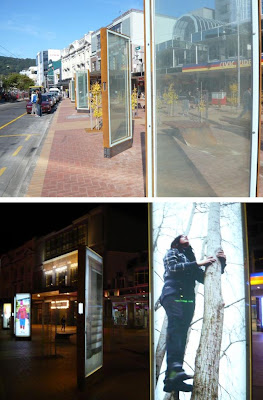
Just as mounting images onto sheet aluminium, the lightbox has become a basic tool for art photographers. Amongst the first to use this display technique (a back-lit transparency in a fluorescent light box) was Canadian Jeff Wall who first used a lightbox to display his 1978 work The Destroyed Room in a shop window. It was part of a movement, of which Wall was a central figure, to create photographic works that would “be more akin to paintings” in scale. In some ways the lightbox has become something of a cliché, a thought that was obviously in Michael Parekowhai’s mind, when he backgrounded his sculptured piano The Story of a New Zealand River with an lightbox displaying a photograph of an outdoor panorama. Over the last few days in Wellington, a set of lightbox photographs have been unwrapped in the new Coutenay Place Park. As you can see, before the transparencies were added what we had was more like a Donald Judd installation. Now it's been revealed as photography, this time dressed up not so much as painting as sculpture.
Images: Top, before and bottom, after
Posted by
jim and Mary
at
7:09 AM
![]()
![]()
Labels: photography, public sculpture
Monday, May 05, 2008
Art is where you find it

Maybe not the best Parkour in the world still, where else but in sculpty-Wellington, would lads like these pass by four public sculptures by five of the …er lads. In order: Matt Pine, Ralph Hotere, Bill Culbert, Neil Dawson and Para Matchitt. And, while we’re on a guy theme, you can chuck in a couple of architects: Ian Athfield and Rewi Thompson.
Posted by
jim and Mary
at
6:54 AM
![]()
![]()
Labels: Art is where you find it
Saturday, May 03, 2008
Thanks guys

How ever pointy their preferences, you have to admit the Wellington Sculpture Trust has never come close to doing to us what has been done to the people of Heidelberg, Germany.
Images: Meanwhile, in downtown Heidelberg
Posted by
jim and Mary
at
7:57 AM
![]()
![]()
Labels: public sculpture
Friday, May 02, 2008
When art goes to the movies 2

Dr No will always be remembered as the first time Sean Connery said the words, “The name is Bond, James Bond” or, more likely, for Honey Rider (Ursula Andress) appearing out of the ocean holding a couple of large sea shells and singing Under the Mango Tree. But, for the art lovers who didn’t catch the Birth of Venus reference, Dr No will always be the Spanish painter Francisco de Goya.
Early in the morning on 21 August 1961 Goya’s portrait of the Duke of Wellington was stolen from the National Gallery in London. It had only been hanging for three weeks after its purchase by the Gallery for $392,000 to prevent its export from the country. The alleged thief, Kempton Bunton, slipped the painting under his coat and walked out unnoticed.
Dr. No was shot the following year at Pinewood Studios and premiered on 5 October. As James Bond and Honey Rider walk up the stairs to join the evil Dr Julias No for dinner in his lair, Bond spots the painting on an easel by the stairs and does a double take. "So that's where that went". In the real world the painting was recovered in 1964.
Others in this series: A Clockwork Orange, Wall Street
Posted by
jim and Mary
at
7:11 AM
![]()
![]()
Labels: art in the movies
Thursday, May 01, 2008
The April shower
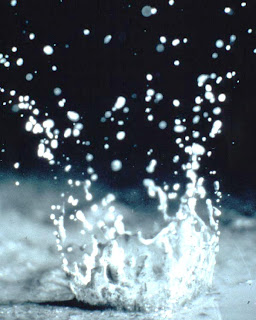
Last month we: got some good oil on Larry • puzzled over why Monet is doing a come back tour at Te Papa • wondered about the Walters Prize • threw a couple of stones at a glass house • noticed all the notices at the Dowse • started our When art goes to the movies series • pondered on the rise and rise of auction houses • gasped at Hamish Keith shamelessly blaming a building for something that wasn’t its fault • tried to visit The Emporors Club and popped the question, why are public gallery web sites so…er…boring?
Image: Rain drop photographed in April
Search us
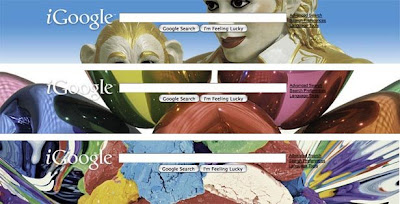
Google has just offered art themes for your Google search page. New Zealand’s Anne Geddes is represented and, as you can see above, so is one of OTN’s regulars Jeff Koons.
Twin Peaks
“Well it’s interesting that both John (Reynolds) and Peter (Robinson) have been nominated twice, and you have to wonder. They’re on such a roll in their practice at the moment, if they keep working at this level will future judges keep putting them back in as well. This is the 4th Walters, so we’re just starting to see patterns arise. So it will be very interesting if it is the same people at the top of their game that start to dominate, or if these artists have peaks and troughs in their careers and Peter and John are both at a real peak at the moment.”
Andrew Clifford, Walters Prize shortlist selector, discussing the competition on The Arts on Sunday. You can hear the rest here.
Posted by
jim and Mary
at
7:44 AM
![]()
![]()
Labels: Walters Prize


